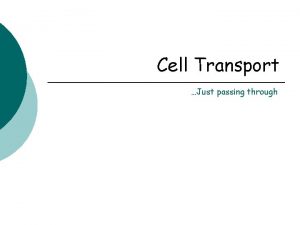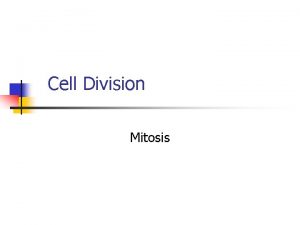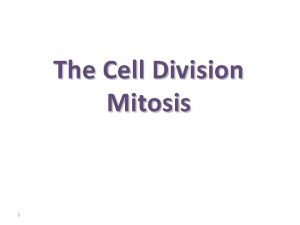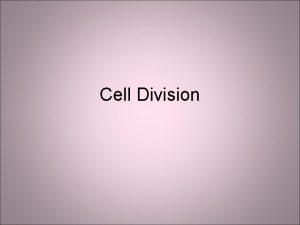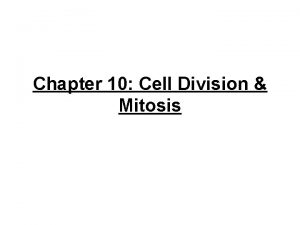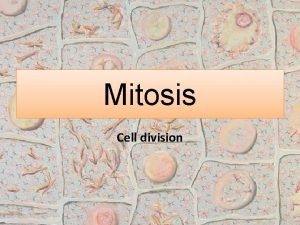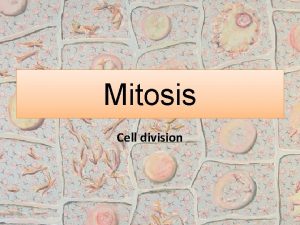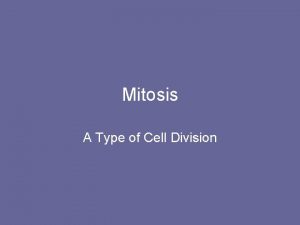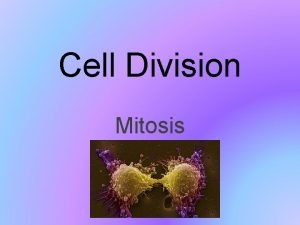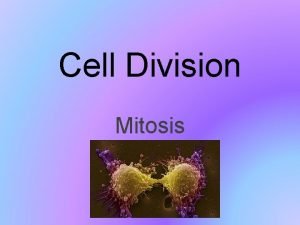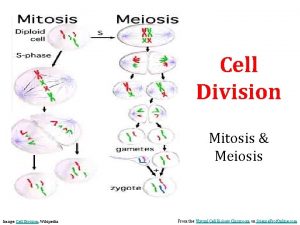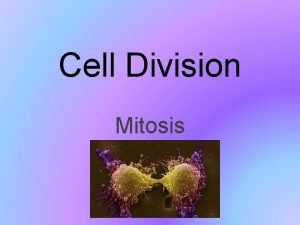Cell Division Mitosis Mitosis Mitosis is just one





















- Slides: 21

Cell Division Mitosis

Mitosis • Mitosis is just one part of the cell cycle • The Mitotic (M) phase is the shortest part of the cell cycle (Cytokinesis may be included in this phase) • Mitosis is a continuum, but can be separated into 4 phases

Mitosis • Prophase • Metaphase • Anaphase • Telophase

Prophase • Chromatin condenses and becomes visible in the light microscope as chromosomes. • The nucleolus disappears. • Centrioles begin moving to opposite ends of the cell • Mitotic spindle begins to form

Metaphase • Nuclear membrane dissolves • Spindle fibres align the chromosomes along the middle of the cell nucleus.

Anaphase • The paired chromatids separate at the kinetochores and move to opposite sides of the cell. • Speed of 1μm/min

Telophase • Chromatids arrive at opposite poles of cell • New membranes form around the daughter nuclei. • The chromosomes disperse and are no longer visible under the light microscope. • The spindle fibres disperse • Cytokinesis may also begin during this stage.

Cytokinesis • In animal cells, cytokinesis results when a fibre ring composed of a protein called actin around the centre of the cell contracts pinching the cell into two daughter cells, each with one nucleus. • In plant cells, the rigid wall requires that a cell plate be synthesized between the two daughter cells.


• http: //uk. youtube. com/watch? v=s 4 Pa. Oz 7 e WS 8&feature=related

Plant roots grow by mitotic division of the cells at the root tip Onion root tips are an ideal source of material for observing the stages of mitosis • A scalpel is used to cut about 4 mm from the tip of the growing onion root • Acetic acid is added to the tip on a watch glass and warmed gently for about 5 minutes; the acid helps to macerate the cells • The root tip is transferred to a slide where two or three drops of aceto-orcein stain are added; this stain is taken up by the chromosomes and makes them more visible as they stain red • The tip is gently broken up with a mounted needle and the cells are spread across the slide • A coverslip is placed over the root preparation and gently squashed • The slide is examined for stages of mitosis using an optical microscope

Photomicrograph showing cells from an onion root tip Note that many of the cells are in interphase

The different phases of the cell cycle last for different periods of time An onion root slide was examined for the different stages of the cell cycle and the number of cells in each phase was recorded The percentage of cells in each stage was then calculated The % of cells in each stage is used as a measure of the % of time that the cells spend in each phase of the cell cycle Interphase is the longest stage of the cell cycle with anaphase being the shortest Number of Cells Cell % (approx. ) Interphase 138 66 Prophase 56 27 Metaphase 6 3 Anaphase 2 1 Telophase 7 3 209 100 Stage of Cell Cycle Total

Cancer When the cell cycle goes wrong

Scanning electron micrograph of dividing cancer cells

When a normal body cell mutates it may divide to produce a clone of cells that form a tumour mutation normal body cell mitosis mutated body cell tumour Many such tumours are found to be BENIGN and do not spread from their site of origin – they may nevertheless compress and damage adjacent tissues Malignant, cancerous tumours may spread from their site of origin These tumours develop their own blood and lymph supply which can transport malignant cells from the tumour to other sites in the body malignant cancer cells carried to other body sites malignant tumour these cells invade other body regions to form secondary cancers This is called metastasis secondary tumour

Introduction to Meiosis

Meiosis is another form of cell division that is associated with reproduction in many organisms In humans, meiosis is responsible for the formation of the reproductive cells or gametes In humans, these are the egg and sperm cells Whereas most body cells have a complement of 23 pairs of chromosomes, human gametes possess only 23 single chromosomes. A gamete’s complement of 23 single chromosomes is constituted by one chromosome taken from each of the 23 pairs of chromosomes Within the human ovaries and testes, gametes are produced by meiosis and this process halves the chromosome number Human body cells are DIPLOID as they possess two sets of chromosomes (23 pairs) Human gametes are described as being HAPLOID as they possess only one set of chromosomes (23 chromosomes) SPERM If the gametes were diploid then the number of CELL chromosomes would double at every generation after fertilisation EGG CELL

MITOSIS MEIOSIS Diploid body cell The nucleus divides twice Two diploid daughter cells Meiosis is important as it ensures that, when the gametes fuse at fertilisation, the normal diploid number of chromosomes is maintained; meiosis is also an important source of genetic variation Four haploid, genetically different gametes are produced

Significance of Meiosis • Introduces some genetic variation • Maintains genetic stability • Each haploid (n) gamate carries only 1 gene for a particular characteristic • Crossing over leads to new combinations of genes • Independent assortment of chromosomes mixes up combinations of chromosomes 20

21
 Cell division mitosis and meiosis
Cell division mitosis and meiosis Cell division mitosis and meiosis
Cell division mitosis and meiosis Mitosis cell division
Mitosis cell division Cell cycle and cell division
Cell cycle and cell division Cell cycle and cell division
Cell cycle and cell division Cell cycle and cell division
Cell cycle and cell division Who is the first person to arrive at juliet's tomb
Who is the first person to arrive at juliet's tomb Just passing through cell membrane
Just passing through cell membrane Long division and short division
Long division and short division Polynomial long division definition
Polynomial long division definition Long divison steps
Long divison steps Synthetic dovision
Synthetic dovision One god one empire one emperor
One god one empire one emperor One one little dog run
One one little dog run One king one law one faith
One king one law one faith One empire one god one emperor
One empire one god one emperor One team one plan one goal
One team one plan one goal See one do one teach one
See one do one teach one One price policy
One price policy Night structure
Night structure See one do one teach one
See one do one teach one Asean tourism strategic plan
Asean tourism strategic plan







